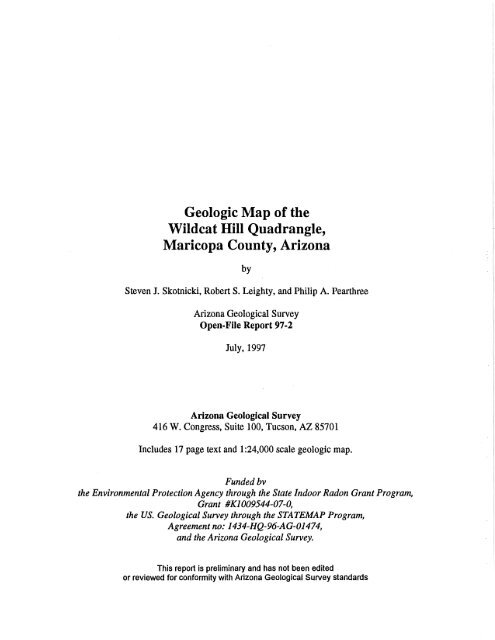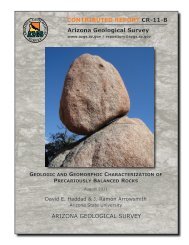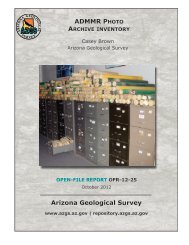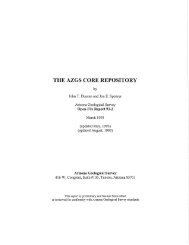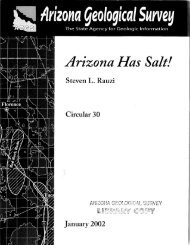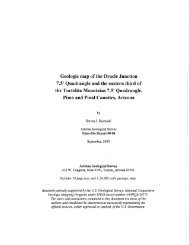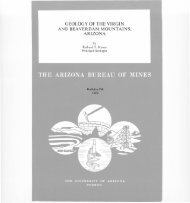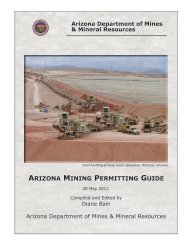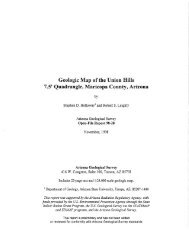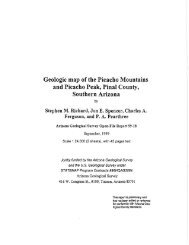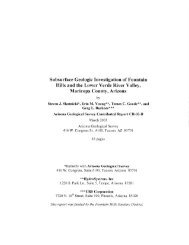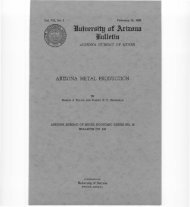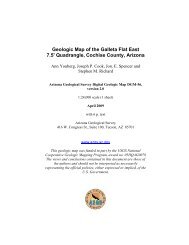Geologic Map of the Wildcat Hill Quadrangle, Maricopa County ...
Geologic Map of the Wildcat Hill Quadrangle, Maricopa County ...
Geologic Map of the Wildcat Hill Quadrangle, Maricopa County ...
You also want an ePaper? Increase the reach of your titles
YUMPU automatically turns print PDFs into web optimized ePapers that Google loves.
<strong>Geologic</strong> <strong>Map</strong> <strong>of</strong> <strong>the</strong><br />
<strong>Wildcat</strong> <strong>Hill</strong> <strong>Quadrangle</strong>,<br />
<strong>Maricopa</strong> <strong>County</strong>, Arizona<br />
by<br />
Steven J. Skotnicki, Robert S. Leighty, and Philip A. Pearthree<br />
Arizona <strong>Geologic</strong>al Survey<br />
Open-File Report 97-2<br />
July, 1997<br />
Arizona <strong>Geologic</strong>al Survey<br />
416 W. Congress, Suite 100, Tucson, AZ 85701<br />
Includes 17 page text and 1 :24,000 scale geologic map.<br />
Funded bv<br />
<strong>the</strong> Environmental Protection Agency through <strong>the</strong> State Indoor Radon Grant Program,<br />
Grant #KI009544-07-0,<br />
<strong>the</strong> US. <strong>Geologic</strong>al Survey through <strong>the</strong> STATEMAP Program,<br />
Agreement no: 1434-HQ-96-AG-01474,<br />
and <strong>the</strong> Arizona <strong>Geologic</strong>al Survey.<br />
This report is preliminary and has not been edited<br />
or reviewed for conformity with Arizona <strong>Geologic</strong>al Survey standards
INTRODUCTION<br />
The <strong>Wildcat</strong> <strong>Hill</strong> quadrangle is centered about six miles directly east <strong>of</strong> <strong>the</strong> town <strong>of</strong> Carefree,<br />
Arizona on <strong>the</strong> nor<strong>the</strong>astern fringe <strong>of</strong> <strong>the</strong> Phoenix metropolitan area (Figure 1). Most <strong>of</strong> <strong>the</strong><br />
central and western portions <strong>of</strong> <strong>the</strong> quadrangle are within <strong>the</strong> corporate boundaries <strong>of</strong> <strong>the</strong> City <strong>of</strong><br />
Scottsdale. In <strong>the</strong> east <strong>the</strong> region includes <strong>the</strong> upper reaches <strong>of</strong> Camp Creek and <strong>the</strong> lower-crustal<br />
xenolith-bearing latite lavas <strong>of</strong> Blue Mountain. Topographic reliefis low through most <strong>of</strong> <strong>the</strong> map<br />
area, with a few hills rising above a broad pediment formed on granitic rocks. The map that<br />
accompanies this report characterizes <strong>the</strong> bedrock and surficial geology <strong>of</strong> <strong>the</strong> <strong>Wildcat</strong> <strong>Hill</strong><br />
quadrangle, and this report summarizes <strong>the</strong> geology and geologic hazards <strong>of</strong> <strong>the</strong> quadrangle.<br />
Access to <strong>the</strong> region is generally good. The paved Cave Creek Road connects Carefree with<br />
<strong>the</strong> Horseshoe Dam Road in <strong>the</strong> nor<strong>the</strong>rn part <strong>of</strong> <strong>the</strong> quadrangle. Much <strong>of</strong> <strong>the</strong> nor<strong>the</strong>ast part <strong>of</strong><br />
<strong>the</strong> study area has been extensively developed, and includes at least one large, gated golf<br />
community. Just south <strong>of</strong> <strong>the</strong> map area, <strong>the</strong> paved Rio Verde Road (Dynamite Road) connects<br />
Pima Road in <strong>the</strong> west with <strong>the</strong> McDowell Mountain Road in <strong>the</strong> east. Several good to fair dirt<br />
roads extend northward from Rio Verde Road into <strong>the</strong> study area. Several paved roads snake<br />
through developments south, west and northwest <strong>of</strong> <strong>the</strong> basalt hills near Browns Ranch.<br />
<strong>Map</strong>ping <strong>of</strong> bedrock in <strong>the</strong> quadrangle was based primarily on extensive field investigations.<br />
Surficial geologic mapping was based both on field observations and interpretation <strong>of</strong> black-andwhite,<br />
1:48,OOO-scale aerial photographs (dated 9-17-92) and color, 1:24,OOO-scale aerial<br />
photographs (dated 6-11-88) obtained from <strong>the</strong> Tonto National Forest. This study is contiguous<br />
with geologic mapping recently completed to <strong>the</strong> south (Skotnicki, 1996a), east (Skotnicki,<br />
1996b), and west (Leighty and o<strong>the</strong>rs, .1997). This project was funded by <strong>the</strong> Environmental<br />
Protection Agency through <strong>the</strong> State Indoor Radon Grant Program, Grant #KI009544-07-0, <strong>the</strong><br />
U.S. <strong>Geologic</strong>al Survey through <strong>the</strong> STATEMAP Program, Grant #, and <strong>the</strong> Arizona <strong>Geologic</strong>al<br />
Survey.<br />
PREVIOUS STUDIES<br />
The sou<strong>the</strong>rn part <strong>of</strong> <strong>the</strong> study area was mapped by Pewe and o<strong>the</strong>rs (1983) as part <strong>of</strong> a<br />
reconnaissance environmental geology study <strong>of</strong> nor<strong>the</strong>rn Scottsdale. Kenny (1986) mapped <strong>the</strong><br />
western part <strong>of</strong><strong>the</strong> <strong>Wildcat</strong> <strong>Hill</strong> quadrangle as part <strong>of</strong> a study <strong>of</strong> <strong>the</strong> Tonto Foothills area. This<br />
same work was also published by Pewe and o<strong>the</strong>rs (1985). Doom and Pewe (1991) made <strong>the</strong><br />
most detailed geologic and gravimetric study <strong>of</strong> <strong>the</strong> Cave Creek-Carefree area (<strong>the</strong> Carefree<br />
Basin). They subdivided <strong>the</strong> basin-fill sedimentary rocks into sub-units and compiled data from<br />
drill logs. Andy Oventile (oral communication) made a preliminary unpublished study <strong>of</strong> <strong>the</strong> latite<br />
and xenoliths at Blue Mountain, which were earlier examined in detail by Esperanya (1984).<br />
Esperanya (1984), and Esperanya and Holloway (1986) reported detailed Sr, Nd, and Pb isotopic<br />
and geochemical data from <strong>the</strong> xenoliths at Blue Mountain. Esperanya and o<strong>the</strong>rs (1988)<br />
conducted oxygen fugacity and H20 activity experiments on <strong>the</strong> latites from <strong>the</strong> same location.<br />
Skotnicki (1996a) mapped <strong>the</strong> Bartlett Dam quadrangle to <strong>the</strong> east and part <strong>of</strong> <strong>the</strong> McDowell<br />
Peak quadrangle to <strong>the</strong> south (Skotnicki, 1996b). Leighty and o<strong>the</strong>rs (1997) made a detailed map<br />
<strong>of</strong> <strong>the</strong> Cave Creek quadrangle to <strong>the</strong> west.<br />
1
• Tertiary volcanic and sedimentary rocks<br />
Proterozoic granitic and metamorphic rocks<br />
Figure 2. Index map showing place names and geographic locations in <strong>the</strong> <strong>Wildcat</strong> <strong>Hill</strong> quadrangle.
GEOLOGIC SETTING<br />
The study area is situated on <strong>the</strong> boundary between <strong>the</strong> Basin-and-Range province and <strong>the</strong><br />
Transition Zone. The boundary is more clearly defined to <strong>the</strong> west in <strong>the</strong> Cave Creek quadrangle<br />
where expansive, shallowly dipping plateaus <strong>of</strong> Tertiary sedimentary and volcanic rocks are<br />
abruptly faulted and tilted along <strong>the</strong> nor<strong>the</strong>rn margin <strong>of</strong> <strong>the</strong> quadrangle. The boundary is not welldefined<br />
in <strong>the</strong> <strong>Wildcat</strong> <strong>Hill</strong> quadrangle but projects into it in <strong>the</strong> northwest comer somewhere near<br />
Lone Mountain. The study area also encompasses <strong>the</strong> eastern third <strong>of</strong> <strong>the</strong> Carefree basin, as<br />
described by Doom and Pewe (1991). The basin is defined by Tertiary volcanic and sedimentary<br />
rocks on <strong>the</strong> north and south margins that dip inward toward a central structural basin filled with<br />
late Tertiary and Quaternary sediments.<br />
Proterozoic Rocks<br />
The region is dominated by nonfoliated, coarse-grained Proterozoic granite that underlies a<br />
broad, dome-like pediment (named <strong>the</strong> Pinnacle Peak pediment by Doorn and Pewe, 1991) which<br />
forms <strong>the</strong> low divide in <strong>the</strong> center <strong>of</strong> <strong>the</strong> map and underlies most <strong>of</strong><strong>the</strong> map area. The granite<br />
intrudes Proterozoic metamorphic rocks composed mostly <strong>of</strong> fine-grained dark gray siltstones and<br />
minor interbedded sandstones, all metamorphosed to slate, phyllite, and (near <strong>the</strong> granite contact)<br />
schist. These rocks are generally low-grade (greenschist facies or lower) and porphyroblasts are<br />
recognizable only east <strong>of</strong><strong>the</strong> prospects marked in section 8, T. 6 N., R. 5 E., and within about<br />
500 feet <strong>of</strong><strong>the</strong> granite contact. The most common porphyroblasts are small, dark gray, oval forms<br />
1-3 mm long which may be albite. Near <strong>the</strong> granite contact coarse-grained muscovite up to 1 cm<br />
wide, smaller biotite, and possibly sillimanite crystals are common. Fraesfield Mountain on <strong>the</strong><br />
sou<strong>the</strong>rn boundary <strong>of</strong> <strong>the</strong> map is underlain by gray, mature quartzite, very similar to quartzite in<br />
<strong>the</strong> nor<strong>the</strong>rn end <strong>of</strong> <strong>the</strong> McDowell Mountains to <strong>the</strong> south (Skotnicki, 1996a).<br />
Tertiary Rocks<br />
Overlying <strong>the</strong> granite is a sequence <strong>of</strong> middle Tertiary rocks. The oldest Tertiary rocks are<br />
red- to tan-colored conglomerates and sandstones exposed at Blue Mountain, in <strong>the</strong> hills to <strong>the</strong><br />
southwest near Browns Ranch, and at Lone Mountain. At Blue Mountain and Browns Ranch <strong>the</strong><br />
conglomerate is composed <strong>of</strong> moderately well-sorted pebble-size granite grus, and is very similar<br />
to deposits to <strong>the</strong> east near Bartlett Lake (Skotnicki, 1996b). Near Browns Ranch <strong>the</strong> uppermost<br />
1-2 meters contains cobble- to boulder-size clasts <strong>of</strong> biotite-rich felsic volcanic rock (probably<br />
equivalent to map unit Tf at Blue Mountain). Doom and Pewe (1991) did not recognize this unit<br />
as a conglomerate and instead called it decomposed in-situ granite. At Lone Mountain <strong>the</strong><br />
conglomerate is composed <strong>of</strong> abundant dark gray clasts <strong>of</strong> metasiltstone and large cobbles and<br />
boulders <strong>of</strong> coarse-grained granite. The deposits thicken to <strong>the</strong> sou<strong>the</strong>ast where <strong>the</strong>y are<br />
dominated by granitic clasts. These conglomerates contain only rare basalt fragments and are<br />
dominantly pre-volcanic. An exception is nor<strong>the</strong>ast <strong>of</strong> Blue Mountain where scoria-rich<br />
volcaniclastic sediments or air-fall deposits are sandwiched between layers <strong>of</strong> grusy conglomerate.<br />
4
Blue Mountain. At Blue Mountain red-tan grusy conglomerate is overlain by resistant, blue-gray<br />
latite. Esperan
In <strong>the</strong> central part <strong>of</strong> <strong>the</strong> study area lithic-rich bedded tuffs overlie granite. They contain clasts<br />
<strong>of</strong> crystal-rich felsic lava and are intruded by crystal-poor, flow-banded rhyolite. North and south<br />
<strong>of</strong> <strong>the</strong> rhyolite plugs are several north-south trending crystal-poor rhyolite dikes. They intrude<br />
granite and were probably emplaced at <strong>the</strong> same time as <strong>the</strong> plugs.<br />
STRUCTURE<br />
The west-central portion <strong>of</strong> <strong>the</strong> map contains <strong>the</strong> eastern edge <strong>of</strong> <strong>the</strong> Carefree basin.<br />
Quaternary surficial deposits cover most <strong>of</strong> <strong>the</strong> basin, but older, tilted sedimentary and volcanic<br />
rocks are exposed at both <strong>the</strong> nor<strong>the</strong>rn and sou<strong>the</strong>rn boundaries. To <strong>the</strong> south near Brown's<br />
Ranch, tan-colored basalt-rich conglomerates (map unit Tsy) overlying basalt dip to <strong>the</strong> north. To<br />
<strong>the</strong> north, a small outcrop <strong>of</strong>Tsy overlies basalt and older conglomerate (map unit Tc). These two<br />
exposures dip toward each o<strong>the</strong>r, toward <strong>the</strong> center <strong>of</strong> <strong>the</strong> basin. This is consistent dips in rocks<br />
west <strong>of</strong> <strong>the</strong> <strong>Wildcat</strong> <strong>Hill</strong> quadrangle, north and south <strong>of</strong> Cave Creek.<br />
In <strong>the</strong> northwest corner <strong>of</strong> <strong>the</strong> quadrangle west-north west-trending faults locally separate<br />
Proterozoic meta-sedimentary rocks on <strong>the</strong> north from non-foliated Proterozoic granite on <strong>the</strong><br />
south. Exposures <strong>of</strong> <strong>the</strong> faults are poor--mostly covered with slope wash--but where visible, both<br />
rocks are highly brecciated and fractured. Besides a red coloration caused by hematite, no o<strong>the</strong>r<br />
mineralization was seen and no pits have been dug into <strong>the</strong> fault zones. Offset <strong>of</strong><strong>the</strong> nor<strong>the</strong>aststriking<br />
intrusive contact, as well as better exposures <strong>of</strong> <strong>of</strong>fset meta-sedimentary rocks in <strong>the</strong> Cave<br />
Creek quadrangle to <strong>the</strong> west, indicates that <strong>the</strong>se are predominantly strike-slip faults with locally<br />
up to 1 kilometer <strong>of</strong> right-lateral displacement. Anderson (1989, page 82), in a figure included<br />
with his discussion <strong>of</strong> <strong>the</strong> New River/Cave Creek Proterozoic belts, shows several right-lateral<br />
displacements in <strong>the</strong> granite-metamorphic contact expressed by wavy lines but he does not discuss<br />
what <strong>the</strong>y mean.<br />
The eastern side <strong>of</strong> <strong>the</strong> study area is dominated by <strong>the</strong> wide drainage <strong>of</strong> Camp Creek. A northsouth<br />
trending, east-dipping normal fault separates granite on <strong>the</strong> west from basin-fill sediments<br />
(Tsy) on <strong>the</strong> east. Remnants <strong>of</strong>Tsy overlie <strong>the</strong> fault, showing that <strong>the</strong> fault was active during<br />
deposition <strong>of</strong><strong>the</strong> unit. This fault defines <strong>the</strong> northwestern edge <strong>of</strong> <strong>the</strong> sedimentary basin forming<br />
<strong>the</strong> Lower Verde River Valley. It is probably continuous with a north-south trending, east-dipping<br />
normal fault to <strong>the</strong> south, inferred to exist just east <strong>of</strong> Granite Knob in section 8, T. 4 N., R. 4 E.,<br />
<strong>the</strong> McDowell Peak quadrangle. The amount <strong>of</strong> <strong>of</strong>fset along <strong>the</strong> fault is not clear. Conglomerate<br />
(map unit Tc) and latite on Blue Mountain dip mostly to <strong>the</strong> south. The conglomerate-granite<br />
contact on <strong>the</strong> north side <strong>of</strong> <strong>the</strong> Mountain swings down hill to <strong>the</strong> west, where it becomes buried<br />
under alluvium (map unit Qy). This contact does not reappear on <strong>the</strong> west side <strong>of</strong> <strong>the</strong> creek, nor<br />
does <strong>the</strong> latite. Both rocks appear to dive into <strong>the</strong> creek. Nor is <strong>the</strong>re any float <strong>of</strong>latite on <strong>the</strong><br />
west side. Although <strong>the</strong> slope <strong>of</strong> <strong>the</strong> pediment surface on <strong>the</strong> west side <strong>of</strong> Camp Creek dips<br />
between 5° and 10° towards <strong>the</strong> creek, <strong>the</strong> contact between <strong>the</strong> granite and <strong>the</strong> overlying<br />
remnants <strong>of</strong> basin-fill deposits also on <strong>the</strong> west side <strong>of</strong> <strong>the</strong> creek is noticeably steeper--between<br />
20° and 30°. These upper sediments were probably shed from <strong>the</strong> new scarp created when <strong>the</strong><br />
fault was active.<br />
The sou<strong>the</strong>rn and central portions <strong>of</strong> <strong>the</strong> map area are cut by <strong>the</strong> north- to northwest-trending<br />
Carefree fault zone. This north- to northwest-trending fault zone, which we suspect has had a<br />
6
limited amount <strong>of</strong> Quaternary normal displacement, is discussed in detail in <strong>the</strong> "<strong>Geologic</strong><br />
Hazards" section <strong>of</strong> this report.<br />
MINERALIZATION<br />
In section 8, T. 6 N., R. 5 E., in <strong>the</strong> northwest corner <strong>of</strong> <strong>the</strong> map area, two large pits (caved<br />
adits?) were dug into a 20 em-thick quartz vein <strong>of</strong> uncertain orientation containing traces <strong>of</strong><br />
hematite and malachite. Hematite and malachite also coat fractures. The quartz vein intrudes lowgrade<br />
slate/phyllite.<br />
To <strong>the</strong> west in section 9, at <strong>the</strong> nor<strong>the</strong>rn end <strong>of</strong> <strong>the</strong> jeep trail, a roughly circular intrusion <strong>of</strong><br />
white quartz (mostly obscured by workings) seems to be associated with an aureole <strong>of</strong>finergrained<br />
granite. Both <strong>the</strong> finer-grained granite and <strong>the</strong> quartz (mostly <strong>the</strong> quartz) contain<br />
pegmatitic zones and weakly graphic granite. The pegmatites include black tourmaline crystals up<br />
to 10 cm long, golden-brown mica (biotite?) up to 2 cm wide, and less abundant muscovite.<br />
Just nor<strong>the</strong>ast <strong>of</strong> <strong>the</strong> quartz intrusion, in <strong>the</strong> largest isolated remnant <strong>of</strong> meta-siltstone, a few<br />
small, nonfoliated white quartz veins intrude <strong>the</strong> Proterozoic rocks and contain coarse-grained<br />
epidote and red garnet.<br />
The only o<strong>the</strong>r mineralization seen was in small prospect pits containing various amounts <strong>of</strong><br />
quartz, hematite, malachite, and chrysocolla in <strong>the</strong> workings.<br />
GEOLOGIC HAZARDS<br />
A variety <strong>of</strong> potential geologic hazards exist in <strong>the</strong> study area. The primary geologic hazards that<br />
may affect this area are soil problems and flooding; debris flows and rockfalls present very localized<br />
hazards, and <strong>the</strong>re is a fault zone that has probably had some Quaternary activity. Radon, a radioactive<br />
gas that is a decay product <strong>of</strong> uranium, is also a potential hazard because <strong>the</strong> granitic rocks that<br />
underlie most <strong>of</strong> <strong>the</strong> nor<strong>the</strong>rn part <strong>of</strong> <strong>the</strong> quadrangle have elevated uranium concentrations in some<br />
areas. The general character <strong>of</strong> <strong>the</strong>se hazards and <strong>the</strong> areas that may be affected by <strong>the</strong>m are<br />
considered below.<br />
Quaternary Faulting. The 12-km-Iong Carefree fault zone (here defined as <strong>the</strong> series <strong>of</strong><br />
branching north- and northwest-striking faults cutting <strong>the</strong> pediment in <strong>the</strong> center <strong>of</strong> <strong>the</strong> map area)<br />
likely has been active during <strong>the</strong> past few hundred thousand years. This fault zone, which nearly<br />
bisects <strong>the</strong> sou<strong>the</strong>rn and central portion <strong>of</strong> <strong>the</strong> <strong>Wildcat</strong> <strong>Hill</strong> quadrangle, was identified by<br />
Pearthree and Scarborough (1984). They classified it as a probable Quaternary fault on <strong>the</strong> basis<br />
<strong>of</strong> reconnaissance field investigations. The "nor<strong>the</strong>rn" section <strong>of</strong> <strong>the</strong> fault zone consists <strong>of</strong> two<br />
northwest-trending faults located south <strong>of</strong> <strong>Wildcat</strong> <strong>Hill</strong>. The "main" section <strong>of</strong> <strong>the</strong> fault trends<br />
generally north, but <strong>the</strong> trend <strong>of</strong> <strong>the</strong> sou<strong>the</strong>rnmost part <strong>of</strong> <strong>the</strong> fault is northwest. Based on <strong>the</strong><br />
detailed field mapping conducted as part <strong>of</strong> this study, middle Pleistocene alluvial-fan deposits are<br />
likely displaced along both sections <strong>of</strong> <strong>the</strong> fault zone. The total Quaternary displacement across<br />
<strong>the</strong> fault zone is a few meters or less, and we found no evidence that <strong>the</strong> fault has been active<br />
7
during <strong>the</strong> late Pleistocene or Holocene. Because <strong>of</strong><strong>the</strong> minimal topographic relief across <strong>the</strong> fault<br />
zone, <strong>the</strong> long-term slip rate on <strong>the</strong> fault must be very low.<br />
The northwest-trending nor<strong>the</strong>rn faults probably cut middle Pleistocene grusy deposits (unit<br />
Qm) but do not cut late Pleistocene deposits (unit QI). The fault is partially within a pediment<br />
formed in wea<strong>the</strong>red granite, but middle Pleistocene and younger deposits exist along <strong>the</strong> fault.<br />
Topographic relief across <strong>the</strong> fault ranges from one to several meters, down-to-<strong>the</strong>-southwest.<br />
Middle Pleistocene deposits along <strong>the</strong> fault are found almost entirely on <strong>the</strong> downthrown side;<br />
<strong>the</strong>y are moderately dissected and have somewhat clay-rich, reddened soils developed on <strong>the</strong>m.<br />
These deposits likely are faulted, but because <strong>the</strong>y are not well preserved on <strong>the</strong> upthrown side <strong>of</strong><br />
<strong>the</strong> fault, displacement cannot be estimated with certainty. Younger, lower, less dissected, slightly<br />
reddened late Pleistocene deposits cross <strong>the</strong> fault zone without obvious deformation. The fault<br />
itself is not well exposed. At one location sou<strong>the</strong>ast <strong>of</strong> Cave Creek road, however, a roadcut<br />
reveals a zone <strong>of</strong> crushed granite and faulted, unconsolidated grusy deposits juxtaposed within a<br />
distance <strong>of</strong> about 2 m. Near Cave Creek Road, <strong>the</strong> fault has displaced older conglomerate (Tc),<br />
tuff, basalt, and younger basin fill deposits (Tsy) on <strong>the</strong> southwest against granite on <strong>the</strong><br />
nor<strong>the</strong>ast. The units form a small hill that is so unassuming and vegetated that it is barely visible<br />
even from <strong>the</strong> road 10 m away. Along <strong>the</strong> eastern end <strong>of</strong><strong>the</strong> fault <strong>the</strong>re are a few small hills<br />
capped by cemented calcium carbonate that are 1 to 5 m higher than adjacent stream channels.<br />
They may represent <strong>the</strong> remnants <strong>of</strong> petro calcic horizons <strong>of</strong> older alluvial deposits <strong>of</strong> middle to<br />
early Pleistocene age. However, <strong>the</strong> caliche is localized to <strong>the</strong> immediate vicinity <strong>of</strong> <strong>the</strong> fault zone,<br />
which suggests it is related to precipitation <strong>of</strong> carbonate from fluid flow along <strong>the</strong> fault. These<br />
massive carbonate accumulations may be responsible for some <strong>of</strong><strong>the</strong> observed relief across <strong>the</strong><br />
fault. This nor<strong>the</strong>rn fault projects to <strong>the</strong> east-sou<strong>the</strong>ast towards an area <strong>of</strong> bedded tuffs and<br />
rhyolite plugs. The tuffs, like <strong>the</strong> units on <strong>the</strong> north and south sides <strong>of</strong> <strong>the</strong> Carefree Basin, form<br />
two distinct tilt domains. Exposures <strong>of</strong>tuff on <strong>the</strong> north and south sides <strong>of</strong> <strong>the</strong> bisecting eastflowing<br />
drainage dip toward each o<strong>the</strong>r.<br />
Middle Pleistocene alluvial-fan deposits are also likely displaced along <strong>the</strong> main section <strong>of</strong> <strong>the</strong><br />
fault zone. Along this part <strong>of</strong> <strong>the</strong> fault, <strong>the</strong> eastern (upthrown) side <strong>of</strong><strong>the</strong> fault is composed<br />
mainly <strong>of</strong> granite pediment and <strong>the</strong> western (downthrown) side <strong>of</strong> <strong>the</strong> fault consists <strong>of</strong> middle<br />
Pleistocene to Holocene alluvium and granite pediment. Along most <strong>of</strong> this section, it is not clear<br />
whe<strong>the</strong>r or not Pleistocene alluvium is faulted. Near Brown's Ranch, however, middle Pleistocene<br />
alluvium on <strong>the</strong> east side <strong>of</strong> <strong>the</strong> fault is truncated by a gentle, 1 to 2 m high scarp at <strong>the</strong> fault.<br />
Thus, <strong>the</strong> middle Pleistocene alluvium is probably faulted. In this same area, vegetation lineaments<br />
along <strong>the</strong> projection <strong>of</strong> <strong>the</strong> fault cross Holocene and late Pleistocene terraces and fans. There is no<br />
obvious topographic relief across <strong>the</strong> lineaments, however, so we conclude that <strong>the</strong> lineaments are<br />
formed by larger vegetation that has exploited ground water along <strong>the</strong> fault. There are numerous<br />
patches <strong>of</strong> cemented calcium carbonate associated with dissected grusy sediments along <strong>the</strong> west<br />
or southwest side <strong>of</strong> <strong>the</strong> fault. As with similar features described earlier, <strong>the</strong>se may be remnants <strong>of</strong><br />
old alluvial surfaces but more likely represent massive accumulation <strong>of</strong> calcium carbonate along<br />
<strong>the</strong> fault zone.<br />
The Carefree fault zone has probably generated moderately large earthquakes one or more<br />
times during <strong>the</strong> Quaternary, but ruptures are very infrequent. The fault probably ruptured at least<br />
once during <strong>the</strong> middle Pleistocene and has not ruptured during <strong>the</strong> late Pleistocene or Holocene.<br />
8
The amount <strong>of</strong> Quaternary displacement across <strong>the</strong> fault zone is not tightly constrained, but is<br />
almost certainly less than a few meters. This small amount <strong>of</strong> displacement implies that <strong>the</strong><br />
Quaternary slip rate on <strong>the</strong> fault is very low, which is consistent with o<strong>the</strong>r Quaternary faults in<br />
central and sou<strong>the</strong>rn Arizona (Menges and Pearthree, 1989). Nothing is known about <strong>the</strong> amount<br />
<strong>of</strong> displacement that might occur during fault ruptures, but based on historical large earthquakes,<br />
1 to 2 m <strong>of</strong> surface displacement per event is reasonable. Assuming this amount <strong>of</strong> displacement<br />
per event, all <strong>of</strong> <strong>the</strong> topographic relief observed across <strong>the</strong> fault could have been generated in one<br />
or two rupture events. The magnitude <strong>of</strong> prehistoric surface-rupturing earthquakes may be<br />
roughly estimated based on <strong>the</strong> mapped length <strong>of</strong> <strong>the</strong> fault. Using data from historical<br />
earthquakes, Wells and Coppersmith (1994) developed empirical relationships relating faulting<br />
parameters to earthquake magnitude for historical earthquakes. Using 12 km for <strong>the</strong> length <strong>of</strong> <strong>the</strong><br />
fault zone, we estimate that it could generate earthquakes in <strong>the</strong> range <strong>of</strong> magnitude 6.3 to 6.5.<br />
Flooding. Flood hazards <strong>of</strong> <strong>the</strong> area consist <strong>of</strong> potential inundation and erosion associated with <strong>the</strong><br />
relatively large drainage <strong>of</strong> Camp Creek and with <strong>the</strong> small tributary streams that flow across <strong>the</strong><br />
piedmonts <strong>of</strong> <strong>the</strong> area. The valley bottom associated with Camp Creek is covered almost entirely with<br />
deposits <strong>of</strong> Holocene age. This indicates that <strong>the</strong> valley floor has been subject to fluvial erosion and<br />
deposition geologically recently, and much <strong>of</strong> <strong>the</strong> valley floor is likely to be inundated in large floods on<br />
Camp Creek. In <strong>the</strong> absence <strong>of</strong> detailed hydrologic analyses, areas mapped as unit Qy along Camp<br />
Creek should be considered potentially flood prone.<br />
Flood hazards on piedmonts may be subdivided into (1) localized flooding along well-defined<br />
drainages, where <strong>the</strong>re is substantial topographic confinement <strong>of</strong> <strong>the</strong> wash; and (2) widespread<br />
inundation in areas <strong>of</strong> minimal topographic confinement (Le., active alluvial fans). Delineation <strong>of</strong>floodprone<br />
areas along well-defined drainages is fairly straightforward, and <strong>the</strong>se hazards may be mitigated<br />
by avoiding building in or immediately adjacent to washes. Floods leave behind physical evidence <strong>of</strong><br />
<strong>the</strong>ir occurrence in <strong>the</strong> form <strong>of</strong> deposits. Therefore, <strong>the</strong> extent <strong>of</strong> young deposits on piedmonts is an<br />
accurate indicator <strong>of</strong> areas that have been flooded in <strong>the</strong> past few thousand years. These are <strong>the</strong> areas<br />
that are most likely to experience flooding in <strong>the</strong> future. Following this logic, <strong>the</strong> extent <strong>of</strong> potentially<br />
flood-prone areas on a piedmont may be evaluated based on <strong>the</strong> extent <strong>of</strong> young deposits (unit Qy).<br />
The washes that flow across piedmonts <strong>of</strong> <strong>the</strong> <strong>Wildcat</strong> <strong>Hill</strong> quadrangle have small drainage basins<br />
that head on <strong>the</strong> low-relief bedrock pediment. The extent <strong>of</strong> Holocene deposits, including active<br />
channels and low terraces, that are associated with <strong>the</strong>se washes is fairly limited. This geologic<br />
evidence indicates that <strong>the</strong> extent <strong>of</strong> potentially flood-prone areas on piedmonts <strong>of</strong> this quadrangle is<br />
also <strong>of</strong> limited extent. Although topographic relief along <strong>the</strong> washes typically is a few meters or less,<br />
this relief evidently is sufficient to contain <strong>the</strong> largest floods that are generated on <strong>the</strong> washes, and we<br />
have found no geologic evidence <strong>of</strong> alluvial-fan flooding. Holocene deposits are somewhat more<br />
extensive along several <strong>of</strong> <strong>the</strong> washes (see T. 5 N., R. 6 E., Section 7, for example), however,<br />
indicating that flood inundation is more widespread or channel locations have shifted during <strong>the</strong><br />
Holocene.<br />
Soil/substrate Problems. Several types <strong>of</strong> soil/substrate problems may be encountered in <strong>the</strong> <strong>Wildcat</strong><br />
<strong>Hill</strong> quadrangle. Soil compaction or expansion upon wetting or loading may be an important geologic<br />
9
hazard in limited portions <strong>of</strong> <strong>the</strong> quadrangle. Soil instability has caused extensive damage to buildings in<br />
Arizona (Christenson and o<strong>the</strong>rs, 1978; Pewe and Kenny, 1989). Changes in soil volume beneath<br />
structures may cause damage ranging from nuisance cracks to serious structural damage. Deposits that<br />
are susceptible to compaction are typically relatively fine-grained, young sediments. Deposits in <strong>the</strong><br />
area that are candidates for compaction are <strong>the</strong> fine-grained terrace deposits <strong>of</strong> units Qyand Ql. Clayrich<br />
soils associated with <strong>the</strong> well-preserved middle Pleistocene alluvial fans (unit Qm) may have some<br />
potential for shrinking and swelling during dry and wet periods, respectively. However, clay-rich<br />
horizons associated with <strong>the</strong>se surfaces are generally less than 1 m thick.<br />
The presence <strong>of</strong> cemented caliche (petrocalcic soil horizons) or shallow bedrock may impact<br />
construction excavation and leaching potential. Calcium carbonate accumulates in soils in this desert<br />
environment over thousands to hundreds <strong>of</strong> thousands <strong>of</strong> years. Typically, <strong>the</strong> soils associated with<br />
middle Pleistocene alluvium in this area have significant accumulations <strong>of</strong> calcium carbonate, but<br />
carbonate-cemented soil horizons are not common. Progressively less carbonate accumulation is<br />
associated with increasingly younger surfaces, such that Ql and younger deposits have weak carbonate<br />
accumulations. Most <strong>of</strong> <strong>the</strong> map area is composed <strong>of</strong> granitic pediment or very thin mantles <strong>of</strong> alluvial<br />
deposits (typically a few meters or less thick) over pediment. These deposits are typically poorly<br />
indurated and are composed <strong>of</strong> granitic grus and much sand- and silt-sized material shed from <strong>the</strong><br />
granite bedrock. The deposits are fairly easy to dig into but because <strong>the</strong>y are so thin <strong>the</strong>y do not act as<br />
a significant aquifer. After extensive rainfall most run<strong>of</strong>f collects in a myriad <strong>of</strong> younger channels and is<br />
funneled downstream through an extensive system <strong>of</strong> shallow valleys cut through <strong>the</strong> deposits and into<br />
<strong>the</strong> bedrock. Although most <strong>of</strong> <strong>the</strong> exposed granite appears to be highly wea<strong>the</strong>red, construction may<br />
be affected ifbedrock is less wea<strong>the</strong>red in <strong>the</strong> near subsUlface.<br />
Rockfalls and Debris Flows. Rockfalls, small landslides, and debris flows are potential hazards on and<br />
immediately adjacent to steep slopes. Mass movement <strong>of</strong> material on steep slopes in this region<br />
typically is triggered by intense or prolonged periods <strong>of</strong> precipitation (Christenson et al, 1978). Debris<br />
flows are viscous slurries <strong>of</strong> sediment and water that may convey large boulders substantial distances<br />
downslope. In sou<strong>the</strong>rn and central Arizona, nearly all <strong>of</strong> <strong>the</strong> documented historical debris flows have<br />
been restricted to mountain slopes and valleys. Rockfalls and landslides are potential hazards below<br />
bedrock cliffs and where bedrock outcrops exist at or near <strong>the</strong> top <strong>of</strong> steep mountain hillslopes. In<br />
<strong>the</strong>se situations, large rocks that are loosened by wea<strong>the</strong>ring may cascade violently downhill. The<br />
existence <strong>of</strong> large boulders near <strong>the</strong> base <strong>of</strong> a steep slope should be considered evidence <strong>of</strong> potential<br />
rockfall hazard in most cases. Potential rockfall and debris-flow hazards in this quadrangle are limited<br />
to <strong>the</strong> slopes <strong>of</strong> a few <strong>of</strong> <strong>the</strong> higher bedrock hills.<br />
Radon. Uranium is present in all geologic materials, generally in concentrations <strong>of</strong> 1 to 10 parts<br />
per million. When a uranium atom undergoes radioactive decay it begins a long string <strong>of</strong> decays<br />
through a series <strong>of</strong> isotopes that make up <strong>the</strong> uranium decay series. Radioactive decay ends at<br />
stable lead-206. Radon, a colorless, odorless gas, is a member <strong>of</strong> <strong>the</strong> uranium decay series.<br />
Radon produced in <strong>the</strong> ground as part <strong>of</strong> <strong>the</strong> uranium decay series can escape into overlying<br />
homes and o<strong>the</strong>r buildings, and can result in elevated radiation exposure, and associated risk <strong>of</strong><br />
10
cancer, to human lungs. Areas with higher uranium concentrations present greater risk <strong>of</strong><br />
elevated indoor radon levels (Spencer, 1992).<br />
The coarse-grained granite <strong>of</strong> map unit Y g underlies much <strong>of</strong> <strong>the</strong> nor<strong>the</strong>rn part <strong>of</strong> <strong>the</strong> <strong>Wildcat</strong><br />
<strong>Hill</strong> quadrangle, and generally forms gentle slopes and low hills that are not an impediment to<br />
construction <strong>of</strong> new homes or o<strong>the</strong>r buildings. Uranium levels <strong>of</strong> 1 to 13 ppm were measured in<br />
this granite with a portable gamma-ray spectrometer (Harris, 1997). Most measurements revealed<br />
levels <strong>of</strong> 6 ppm or less, which is considered normal, but three measurements were in <strong>the</strong> range 8<br />
to 13 ppm, which is considered anomalous. The high variability <strong>of</strong> uranium levels is possibly due<br />
to different amounts <strong>of</strong> leaching <strong>of</strong> uranium from wea<strong>the</strong>red granite at or near <strong>the</strong> surface. The<br />
occurrence <strong>of</strong> local elevated uranium concentrations, plus <strong>the</strong> generally permeable character <strong>of</strong><br />
wea<strong>the</strong>red granite which allows radon to leak out <strong>of</strong> <strong>the</strong> ground (Peake and Schumann, 1991),<br />
indicate that elevated radon levels in homes built on this granite are probably more likely than on<br />
most o<strong>the</strong>r geologic materials in <strong>the</strong> Phoenix metropolitan area.<br />
REFERENCES<br />
Anderson, Phillip, 1989, Stratigraphic framework, volcanic-plutonic evolution, and vertical<br />
deformation <strong>of</strong> <strong>the</strong> Proterozoic volcanic belts <strong>of</strong> central Arizona, in Jenny, JP., and Reynolds,<br />
S. J, <strong>Geologic</strong> evolution <strong>of</strong> Arizona: Arizona <strong>Geologic</strong>al Society Digest 17, p. 57-147.<br />
Christenson, G.E., Welsch, D.G., and Pewe, T.L., 1978, Folio <strong>of</strong> <strong>the</strong> McDowell Mountains area,<br />
Arizona: Arizona Bureau <strong>of</strong> Geology and Mineral Technology Folio Series No.1, <strong>Map</strong>s GIl-A,<br />
B, scale 1:48,000.<br />
Doorn, P.L., and Pewe, T.L., 1991, <strong>Geologic</strong> and gravimetric investigations <strong>of</strong> <strong>the</strong> Carefree<br />
Basin, <strong>Maricopa</strong> <strong>County</strong>, Arizona: Arizona <strong>Geologic</strong>al Survey Special Paper 8, 187 p., 10<br />
plates, scale 1 :24,000.<br />
Esperan
Kenny, Ray, 1986, Reconnaissance environmental geology <strong>of</strong> <strong>the</strong> Tonto Foothills,<br />
Scottsdale, Arizona: Tempe, Arizona State University, unpub. M.S. <strong>the</strong>sis, 158 p.,<br />
scale 1:24,000.<br />
Leighty, RS., Skotnicki, S.l, and Pearthree, P.A., 1997, <strong>Geologic</strong> map <strong>of</strong><strong>the</strong> Cave Creek<br />
quadrangle, <strong>Maricopa</strong> <strong>County</strong>, Arizona: Arizona <strong>Geologic</strong>al Survey Open-File Report 97-1,<br />
scale 1:24,000.<br />
Menges, C.M., and Pearthree, P.A., 1989, Late Cenozoic tectonism and landscape evolution in<br />
Arizona, in Jenney, l, and Reynolds, S.l, eds., <strong>Geologic</strong> Evolution <strong>of</strong> Arizona: Arizona<br />
<strong>Geologic</strong>al Society Digest 17, p. 649-680.<br />
Peake, RT., and Schumann, RR, 1991, Regional radon characterizations, in Gunderson, L.C.S.,<br />
and Wanty, RB., eds., Field studies <strong>of</strong> radon in rocks, soils, and water: U.S. <strong>Geologic</strong>al<br />
Survey Bulletin 1971, p. 175.<br />
Pearthree, P.A., and Scarborough, RB., 1984, Reconnaissance analysis <strong>of</strong> possible Quaternary<br />
faulting in central Arizona: Arizona Bureau <strong>of</strong> Geology and Mineral Technology Open-File<br />
Report 85-4, 75 p. scale 1: 125,000.<br />
Pewe, T.L., and Kenny, Ray, 1989, Environmental geology <strong>of</strong> Arizona, in Jenney, IP., and<br />
Reynolds, S.l, eds., <strong>Geologic</strong> Evolution <strong>of</strong> Arizona: Arizona <strong>Geologic</strong>al Society Digest 17,<br />
p. 841-862.<br />
Pewe, T.L., and Kenny, Ray, and Bales, Jim, 1985, Reconnaissance environmental geology <strong>of</strong> <strong>the</strong><br />
Tonto foothills, Scottsdale, <strong>Maricopa</strong> <strong>County</strong>, Arizona: Arizona <strong>Geologic</strong>al Survey<br />
Contributed <strong>Map</strong> CM-94-F, scale 1:24,000,4 sheets.<br />
Pewe, T.L., Kenny, Ray, and Montz, Melissa, 1983, Reconnaissance environmental geology <strong>of</strong><br />
nor<strong>the</strong>rn Scottsdale, <strong>Maricopa</strong> <strong>County</strong>, Arizona: Arizona <strong>Geologic</strong>al Survey Contributed<br />
Report CM-94-E, scale 1:24,000,3 sheets.<br />
Skotnicki, S.l, 1996a, <strong>Geologic</strong> map <strong>of</strong> portions <strong>of</strong><strong>the</strong> Fort McDowell and McDowell Peak<br />
quadrangles, <strong>Maricopa</strong> <strong>County</strong>, Arizona: Arizona <strong>Geologic</strong>al Survey Open-File Report 96-<br />
11,20 p., scale 1:24,000.<br />
Skotnicki, S.l, 1996b, <strong>Geologic</strong> map <strong>of</strong> <strong>the</strong> Bartlett Dam quadrangle and sou<strong>the</strong>rn part <strong>of</strong> <strong>the</strong><br />
Horseshoe Dam quadrangle, <strong>Maricopa</strong> <strong>County</strong>, Arizona: Arizona <strong>Geologic</strong>al Survey Open<br />
File Report 96-22,21 p., scale 1:24,000.<br />
Spencer, J. E., 1992, Radon gas: A geologic hazard in Arizona: Arizona <strong>Geologic</strong>al Survey,<br />
Down-to-Earth Series, no. 2, 17 p.<br />
Wells, D.L., and Coppersmith, K.J., 1994, Updated empirical relationships among magnitude,<br />
rupture length, rupture area, and surface displacement: Bulletin <strong>of</strong> <strong>the</strong> Seismological Society<br />
<strong>of</strong> America, v. 84, p. 974-1002.<br />
12
UNIT DESCRIPTIONS<br />
Quaternary Piedmont Deposits:<br />
Qy<br />
QI<br />
Qml<br />
Qm<br />
WILDCAT HILL QUADRANGLE<br />
Holocene alluvium «10 ka). Unconsolidated, poorly sorted sand, gravel and boulder<br />
deposits confined to <strong>the</strong> modern drainages. Larger clasts are metamorphic clasts and<br />
basalt. Smaller clasts are sub angular granite grus. Qy deposits are characterized by<br />
stratified, poorly to moderately sorted sands, gravels, and cobbles frequently mantled by<br />
sandy loam sedIment. On this surface <strong>the</strong> main channel commonly diverges mto braided<br />
channels. Locally exhibits bar and swale topography, <strong>the</strong> bars typically more vegetated.<br />
Soil development is relatively weak with oiily slight texturally or structurally modified B<br />
horizons and slight calcificatlOn (Stage I). Some <strong>of</strong> <strong>the</strong> older Qy soils may contain weakly<br />
developed argillic horizons. Because surface soils are not indurated with clay or calcium<br />
carbonate, some older Qy surfaces have relatively high permeability and porosity.<br />
Late Pleistocene alluvium (10 to 250 ka). Moderately sorted, clast-supported,<br />
moderately consolidated sandstones and conglomerates containing much granite grus in a<br />
tan to brown sand and silt matrix. QI surfaces are moderately incised by stream channels<br />
but still contain constructional, relatively flat interfluvial surfaces. QI soils typically have<br />
moderately clay-rich tan to red-brown argillic horizons. These soils also contain much<br />
pedogenic clay and some calcium carbonate, resulting in relatively low infiltration rates.<br />
Thus <strong>the</strong>se suifaces favor 1?lants that draw moisture from near <strong>the</strong> surface. QI deposits<br />
typically have stage II calCIUm carbonate development.<br />
Middle and late Pleistocene, undivided (10 to 750 kale<br />
Middle Pleistocene alluvium (250 to 750 ka). Sandy to loamy, tan-colored sandstones<br />
and conglomerates. The deposits are moderately consolidated and locally weakly<br />
indurateo by carbonate. Argillic horizons typically are weak to moderate, probably<br />
because <strong>the</strong>y have been eroded. The unit is fairly deeply dissected and original<br />
constructural surfaces are best preserved as only small fan remnants in <strong>the</strong> northwest<br />
corner <strong>of</strong> <strong>the</strong> study area. Here, <strong>the</strong> argillic horizons are strongly developed, but elsewhere<br />
are much weaker to nonexistent on rioge slopes.<br />
Qm2 Younger member <strong>of</strong> <strong>the</strong> middle Pleistocene alluvium.<br />
Qml Older member <strong>of</strong> <strong>the</strong> middle Pleistocene alluvium.<br />
Tertiary rocks:<br />
Tsy Younger sedimentary deposits (late Tertiary). Basin-fill deposits. Interbedded<br />
moderately to poorly sorted sandstones and conglomerates. Contains subrounded to<br />
angular sand- to cooble-sized clasts derived from Proterozoic metamorphic rocks and<br />
Tertiary volcanic and sedimentary rocks, all in a carbonate-rich granite gros matrix. Clast<br />
types and percentages vary slightly with locality. Doorn and Pewe (1991) described all<br />
outcrops <strong>of</strong> this umt in <strong>the</strong> <strong>Wildcat</strong> <strong>Hill</strong> quadran,gle as belonging to <strong>the</strong> Grapevine member<br />
<strong>of</strong> <strong>the</strong> Carefree formation. Most exposures are hthologically similar, except exposures<br />
north <strong>of</strong> Brows Ranch (not recognized by Doorn and Pewe, 1991) where most <strong>of</strong><strong>the</strong><br />
cobble-size clasts are locally denved basalt.<br />
13
Tsyl<br />
Tsl<br />
Tb<br />
Tt<br />
Tfi<br />
TI<br />
Lower unit <strong>of</strong> <strong>the</strong> younger sedimentary deposits (late Tertiary). Moderately to<br />
strongly indurated conglomerate contairung sub angular, locally derived clasts <strong>of</strong>latite<br />
(map unit Tl) and minor lower-crustal xenolith clasts, all in a tan-colored sandy to silty<br />
matrix. Cement is silica. The unit locally contains thin, discontinuous 10-20 cm-thick<br />
lenses <strong>of</strong> granite grus. Beds steepen towards unconformable contact with underlying latite.<br />
This deposit is probably <strong>the</strong> base <strong>of</strong><strong>the</strong> basin-fill deposits (Tsy).<br />
Lacustrine deposits (middle Tertiary). Light gray to tan and white fine-grained<br />
sedimentary deposits composed <strong>of</strong> thirily bedded light gray to tan mudstone, carbonaceous<br />
mudstone, minor fine-grained sandstone, and white siliceous or dolomitic limestone<br />
(marl). Some layers contain abundant carbonate, particularly near <strong>the</strong> base <strong>of</strong> <strong>the</strong> section,<br />
but most rocks barely fizz with HCI, if at all. Claystones are more abundant upward and<br />
are locally tan-colored. S<strong>of</strong>t-sediment deformation is abundant. At <strong>the</strong> top flare structures<br />
intrude <strong>the</strong> overlying basalt. Behind <strong>the</strong> water tank in section 30, T. 6 N., R. 5 E., a 5 cmthick<br />
crumbly tuff bed interbedded with mudstones is exposed about 3 meters below <strong>the</strong><br />
basalt contact. Doom and Pewe (1991) described plant stem and root fossils. This unit is<br />
equivalent to <strong>the</strong> White Eagle Mine Formation (Doorn and Pewe, 1991) exposed to <strong>the</strong><br />
east in <strong>the</strong> Cave Creek quaorangle.<br />
Basalt (middle Tertiary). Contains about 10% anhedral to subhedrall-4 mm wide<br />
phenocrysts <strong>of</strong> iddingsite after olivine in a dark gray aphanitic matrix. Wea<strong>the</strong>rs into dark<br />
resistant hills. This unit contains several different flows, exposed best at Lone Mountain.<br />
The different flows were not mapped as different units, but were differentiated into early<br />
and middle Miocene west <strong>of</strong> <strong>the</strong> map area in <strong>the</strong> Cave Creek quadrangle (Leighty and<br />
Skotnicki, 1996). Doorn and Pewe (1991) reported two K-Ar ages from basalts<br />
underlying and overlying <strong>the</strong> white lacustrine beds at <strong>the</strong> White Eagle Mine, in <strong>the</strong> Cave<br />
Creek quadrangle. The two ages are, respectively, 15.4 Ma and 13.42 ± 0.35 Ma.<br />
Tuff (middle Tertiary). At Lone Mountain this light gray to white lithic tuff contains<br />
rare, anhedral to subhedral biotite, sanidine, and mmor quartz, all less than 2 mm wide.<br />
Also contains gray pumice up to 1 cm wide. Lowermost 5-8 meters is thinly bedded, <strong>the</strong><br />
base <strong>of</strong> which IS nch in basalt clasts. The uppermost 15-20 meters is mostly massive to<br />
thickly bedded. The unit is exposed in <strong>the</strong> southwest part <strong>of</strong> <strong>the</strong> study area where it is<br />
interbedded locally with both conglomerate and basalt. It is also exposed as a thin band<br />
above conglomerate at Lone Mountain in <strong>the</strong> northwest part <strong>of</strong> <strong>the</strong> quadrangle. Locally<br />
well-indurated and forms slopes to small ridges. In <strong>the</strong> central part <strong>of</strong> <strong>the</strong> map <strong>the</strong> unit is<br />
bedded and contains phenocrysts <strong>of</strong> anhedral to subhedral clear quartz up to 4 mm, and<br />
minor biotite, in a purple-pink aphanitic matrix. There it contains abundant clasts <strong>of</strong><br />
crystal-rich felsic lava containing subhedral quartz, chalky white plagioclase, and minor<br />
biotite, in a light grey to pink matrix.<br />
Felsic to intermediate volcanic rocks (middle Tertiary). Almost aphyric lava with very<br />
small phenocrysts <strong>of</strong> biotite and feldspar less than 1 mm wide. Forms resistant hills in <strong>the</strong><br />
central part <strong>of</strong> <strong>the</strong> study area where it intrudes tuff and granite, and forms resistant dikes.<br />
Wea<strong>the</strong>rs light tan.<br />
Latite (middle Tertiary). Light tan to blue-gray lavas containing about 5-10% very small<br />
phenocrysts <strong>of</strong> biotite and plagioclase up to 1 mm wide. Some areas are low density and<br />
crumbly, particularly near base. O<strong>the</strong>r areas are dense and resistant. The rock contains<br />
abundant, well-rounded to sub angular, dark brown lower-crustal xenoliths from 1 to 30<br />
cm wide (see text for descriptions). Clasts <strong>of</strong> felsic volcanic rock in conglomerate near<br />
Browns Ranch: Clasts contain 40-50% phenocrysts <strong>of</strong> subhedral to euhedral biotite,<br />
slightly altered to hematite, and about 5% green olivine--both about 5 mm wide in a pinktan<br />
aphanitic matrix. Biotite crystals are preferentially flattened into parallel1;1lanes forming<br />
a trachytic fabric. Contains sub angular to subrounded xenoliths <strong>of</strong> coarse-gramed brown<br />
biotite, coarse-grained brown amphibole, red garnet, green pyroxene, and basalt, all up to<br />
14
Tcv<br />
Tc<br />
5 cm wide. Same as felsic rock in hills sou<strong>the</strong>ast <strong>of</strong> Carefree in <strong>the</strong> Cave Creek<br />
quadrangle, and may be related to rocks at Blue Mountain.<br />
Volcaniclastic conglomerate (middle Tertiary). Thinly bedded scoria. This unit contains<br />
mostly sub angular sand- to pebble-size clasts <strong>of</strong> red and purple scoria in a tan, silty,<br />
carbonate-rich matrix. The unit is interbedded with granitic conglomerate (map unit Tc) in<br />
<strong>the</strong> nor<strong>the</strong>ast corner <strong>of</strong> <strong>the</strong> map area. It is generally poorly consolidated and crumbles<br />
easily into smooth slopes. Locally, it may be ei<strong>the</strong>r sedimentary or pyroclastic in origin.<br />
Where unequivocally pyroclastic <strong>the</strong> rock contains large, fresh, angular cobble-size clasts<br />
<strong>of</strong> coarse-grained granite.<br />
Conglomerate (middle Tertiary). Contains abundant angular to subrounded, mostly<br />
pebble- to cobble-size clasts derived from map unit Xs, all in a rusty red granite grus<br />
matrix. The matrix is siliceous and contains no carbonate. Moderately consolidated. Forms<br />
dark, rounded slopes and hills. At Lone Mountain <strong>the</strong> unit grades eastward into deposits<br />
containing large rounded boulders <strong>of</strong> coarse-grained granite (map unit Y g) and smaller<br />
angular, fine-grained granite boulders and cobbles and minor XS clast. Northwest <strong>of</strong> Lone<br />
Mountain <strong>the</strong> unit contains interbedded sandstones containing light gray, low-density felsic<br />
volcanic clasts.<br />
Proterozoic intrusive rocks:<br />
Y g(p) Pediment on coarse-grained granite.<br />
Yg<br />
Yd<br />
Coarse-grained granite (middle Proterozoic). Contains phenocrysts <strong>of</strong> abundant light<br />
gray to pink subhedral K -feldspar from 2 to 4 cm long, and subhedral black biotite, light<br />
gray plagioclase and clear-gray quartz all from 2-8 mm wide. Biotite is generally fresh or<br />
slightly altered to hematite and locally possibly chlorite, and occurs in tlun books. Near <strong>the</strong><br />
contact with <strong>the</strong> Proterozoic metamorphic rocks biotite, plagioclase and quartz are locally<br />
finer-grained but <strong>the</strong> K-feldspar phenocrysts generally are not. This unit generally<br />
wea<strong>the</strong>rs into spheroidal boulders and easily erodes into grus which mantles <strong>the</strong> rock<br />
almost everywliere.<br />
Diorite (middle Proterozoic). Dark green, fine-grained intrusive rock. Contains light gray<br />
feldspar, quartz, and dark green ampliibole. Non-foliated. Hand samples are very dIfficult<br />
to break. Exposed in one small outcrop at <strong>the</strong> granite-argilite contact in section 18, T. 6<br />
N., R. 5 E., m <strong>the</strong> northwest corner <strong>of</strong> <strong>the</strong> map.<br />
Proterozoic meta-sedimentary and meta-volcanicrocks:<br />
Xl'<br />
Xq<br />
Rhyolite (early Proterozoic). Fine-grained, light gray to pink, quartz-sericite schist.<br />
Generally contains very small «1 mm) anhedral phenocrysts <strong>of</strong> gray feldspar and quartz.<br />
Locally, <strong>the</strong> rock contains crystals <strong>of</strong>f'eldspar ana milky quartz up to 4 mm wide and<br />
contains elongate lenses <strong>of</strong> fine-grained biotite with <strong>the</strong>ir long axes parallel to foliation. 1-<br />
3 mm wide magnetite porphyroolasts have been altered to hematite. This unit forms only<br />
one small exposure on <strong>the</strong> east side <strong>of</strong>Fraesfield Mountain.<br />
Quartzite (early Proterozoic). Light pink to blue-gray clean quartzite. Bedding is visible<br />
locally, and trough and planar cross-bedding, defined by thin magnetite bands, show that<br />
up-section is to <strong>the</strong> east-nor<strong>the</strong>ast. Intruded by granite (map unit Y g) and forms a resistant<br />
mob at Fraesfield Mountain.<br />
15
Xsp<br />
Xsps<br />
Xc<br />
Pelite (early Proterozoic). Medium to dark gray, fine-grained slate and phyllite. In <strong>the</strong><br />
nor<strong>the</strong>ast this unit contains more massive silicic lenses that break into angular fragments<br />
ra<strong>the</strong>r than thin plates, and were locally mapped separately. Metamorphism grades from a<br />
biotite-muscovite (possibly sillimanite) schist near <strong>the</strong> contact with granite (map unit Yg)<br />
to phyllite and slate. In <strong>the</strong> nor<strong>the</strong>ast corner <strong>of</strong> <strong>the</strong> map foliation is weak to non-existent<br />
and bedding is plainly visible as well as primary sedimentary features such as cross-beds,<br />
graded bedoing, and rare ripple marks. Porphyroblast minerals vary with location and<br />
locally include abundant dark gray, pill-shapeo albite(?) up to 3 mm long, coarse-grained<br />
muscovite, biotite, and large subliedral hematite (after pyrite?) up to 2 cm wide.<br />
Psammite (early Proterozoic). Fine-grained medium to li,ght gray sandstone and minor<br />
conglomerate. Contains subrounded grains <strong>of</strong> light and darI: grey quartz, chalcedony<br />
Gasper), and feldspar, all in a medium gray SiliCIC matrix. Very well-indurated and drfficult<br />
to oreak. Wea<strong>the</strong>rs tan--lighter than <strong>the</strong> gray siltstones (map unit Xs). Also commonly<br />
more resistant than <strong>the</strong> siltstones and forms ridges. Where conglomeratic <strong>the</strong> rock also<br />
contains sub angular to rounded clasts <strong>of</strong>Xsp up to about 4 cm long.<br />
White chert (early Proterozoic). Band <strong>of</strong> light gray to white chert 0-4 meters thick. No<br />
grains nor bedding are visible. Tne rock has a mottled, wormy look, defined by irregular<br />
blotches <strong>of</strong> darker gray chert.<br />
16


